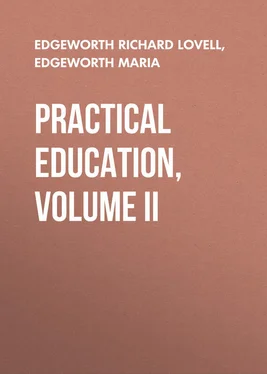Richard Edgeworth - Practical Education, Volume II
Здесь есть возможность читать онлайн «Richard Edgeworth - Practical Education, Volume II» — ознакомительный отрывок электронной книги совершенно бесплатно, а после прочтения отрывка купить полную версию. В некоторых случаях можно слушать аудио, скачать через торрент в формате fb2 и присутствует краткое содержание. Жанр: Прочая научная литература, foreign_edu, foreign_antique, foreign_prose, на английском языке. Описание произведения, (предисловие) а так же отзывы посетителей доступны на портале библиотеки ЛибКат.
- Название:Practical Education, Volume II
- Автор:
- Жанр:
- Год:неизвестен
- ISBN:нет данных
- Рейтинг книги:3 / 5. Голосов: 1
-
Избранное:Добавить в избранное
- Отзывы:
-
Ваша оценка:
- 60
- 1
- 2
- 3
- 4
- 5
Practical Education, Volume II: краткое содержание, описание и аннотация
Предлагаем к чтению аннотацию, описание, краткое содержание или предисловие (зависит от того, что написал сам автор книги «Practical Education, Volume II»). Если вы не нашли необходимую информацию о книге — напишите в комментариях, мы постараемся отыскать её.
Practical Education, Volume II — читать онлайн ознакомительный отрывок
Ниже представлен текст книги, разбитый по страницам. Система сохранения места последней прочитанной страницы, позволяет с удобством читать онлайн бесплатно книгу «Practical Education, Volume II», без необходимости каждый раз заново искать на чём Вы остановились. Поставьте закладку, и сможете в любой момент перейти на страницу, на которой закончили чтение.
Интервал:
Закладка:
Let the skeleton of a pulley be hung by the iron strap from the transom of the frame; fasten a piece of web to one of the radii, and another to the end of the opposite radius. If two boys of equal weight pull these pieces of girth-web, they will balance each other; or two equal weights hung to these webs, will be in equilibrio. If a piece of girth-web be put round the uppermost radius, two equal weights hung at the ends of it will remain immoveable; but if either of them be pulled, or if a small additional weight be added to either of them, it will descend, and the web will apply itself successively to the ascending radii, and will detach itself from those that are descending. If this movement be carefully considered, it will be perceived, that the web, in unfolding itself, acts in the same manner upon the radii as two ropes would if they were hung to the extremities of the opposite radii in succession. The two radii which are opposite, may be considered as a lever of the first sort, where the centre is in the middle of the lever; as each end moves through an equal space, there is no mechanical advantage. But if this skeleton-pulley be employed as a common block or tackle , its motions and properties will be entirely different.
Nail a piece of girth-web to a post, at the distance of three or four feet from the ground; fasten the other end of it to one of the radii. Fasten another piece of web to the opposite radius, and let a boy hold the skeleton-pulley suspended by the web; hook weights to the strap that hangs from the centre. The end of the radius to which the fixed girth-web is fastened, will remain immoveable; but, if the boy pulls the web which he holds in his hand upwards, he will be able to lift nearly double the weight, which he can raise from the ground by a simple rope, without the machine, and he will perceive that his hand moves through twice as great a space as the weight ascends: he has, therefore, the mechanical advantage which he would have by a lever of the second sort, as in Experiment iii. Let a piece of web be put round the under radii, let one end of it be nailed to the post, and the other be held by the boy, and it will represent the application of a rope to a moveable pulley; if its motion be carefully considered, it will appear that the radii, as they successively apply themselves to the web, represent a series of levers of the second kind. A pulley is nothing more than an infinite number of such levers; the cord at one end of the diameter serving as a fulcrum for the organ during its progress. If this skeleton-pulley be used horizontally, instead of perpendicularly, the circumstances which have been mentioned, will appear more obvious.
Upon the wooden road lay down a piece of girth-web; nail one end of it to the road; place the pulley upon the web at the other end of the board, and, bringing the web over the radii, let the boy, taking hold of it, draw the loaded sledge fastened to the hook at the centre of the pulley: he will draw nearly twice as much in this manner as he could without the pulley. 24 24 In all these experiments with the skeleton-pulley, somebody must keep it in its proper direction; as from its structure, which is contrived for illustration, not for practical use, it cannot retain its proper situation without assistance.
Here the web lying on the road, shows more distinctly, that it is quiescent where the lowest radius touches it; and if the radii, as they tread upon it, are observed, their points will appear at rest, whilst the centre of the pulley will go as fast as the sledge, and the top of each radius successively (and the boy's hand which unfolds the web) will move twice as fast as the centre of the pulley and the sledge.
If a person, holding a stick in his hand, observes the relative motions of the top, and the middle, and the bottom of the stick, whilst he inclines it, he will see that the bottom of the stick has no motion on the ground, and that the middle has only half the motion of the top. This property of the pulley has been dwelt upon, because it elucidates the motion of a wheel rolling upon the ground; and it explains a common paradox, which appears at first inexplicable. "The bottom of a rolling wheel never moves upon the road." This is asserted only of a wheel moving over hard ground, which, in fact, may be considered rather as laying down its circumference upon the road, than as moving upon it.
The inclined plane is to be next considered. When a heavy body is to be raised, it is often convenient to lay a sloping artificial road of planks, up which it may be pushed or drawn. This mechanical power, however, is but of little service without the assistance of wheels or rollers; we shall, therefore, speak of it as it is applied in another manner, under the name of the wedge , which is, in fact, a moving inclined plane; but if it is required to explain the properties of the inclined plane by the panorganon, the wooden road may be raised and set to any inclination that is required, and the sledge may be drawn upon it as in the former experiments.
Let one end of a lever, N. Plate 2. Fig. 7. with a wheel at one end of it, be hinged to the post of the frame, by means of a gudgeon driven or screwed into the post. To prevent this lever from deviating sideways, let a slip of wood be connected with it by a nail, which shall be fast in the lever, but which moves freely in a hole in the rail. The other end of this slip must be fastened to a stake driven into the ground at three or four feet from the lever, at one side of it, and towards the end in which the wheel is fixed (Plate 2. Fig 10. which is a vue d'oiseau ) in the same manner as the treadle of a common lathe is managed, and as the treadle of a loom is sometimes guided. 25 25 In a loom this secondary lever is called a lamb , by mistake, for lam ; from lamina , a slip of wood.
Конец ознакомительного фрагмента.
Текст предоставлен ООО «ЛитРес».
Прочитайте эту книгу целиком, купив полную легальную версию на ЛитРес.
Безопасно оплатить книгу можно банковской картой Visa, MasterCard, Maestro, со счета мобильного телефона, с платежного терминала, в салоне МТС или Связной, через PayPal, WebMoney, Яндекс.Деньги, QIWI Кошелек, бонусными картами или другим удобным Вам способом.
1
Garretson's Exercises, the tenth edition.
2
V. Chapter on Attention.
3
Mrs. Piozzi.
4
V. Blair.
5
V. Plutarch.
6
Valpy's Exercises.
7
V. Darwin's Poetry.
8
Since the above was written, we have seen a letter from Dr. Aikin to his son on the morality and poetic merit of the fable of Circe, which convinces us that the observations that we have hazarded are not premature.
9
Chapter on Imagination.
10
We speak of these engravings as beautiful , for the times in which they were done; modern artists have arrived at higher perfection.
11
Интервал:
Закладка:
Похожие книги на «Practical Education, Volume II»
Представляем Вашему вниманию похожие книги на «Practical Education, Volume II» списком для выбора. Мы отобрали схожую по названию и смыслу литературу в надежде предоставить читателям больше вариантов отыскать новые, интересные, ещё непрочитанные произведения.
Обсуждение, отзывы о книге «Practical Education, Volume II» и просто собственные мнения читателей. Оставьте ваши комментарии, напишите, что Вы думаете о произведении, его смысле или главных героях. Укажите что конкретно понравилось, а что нет, и почему Вы так считаете.












